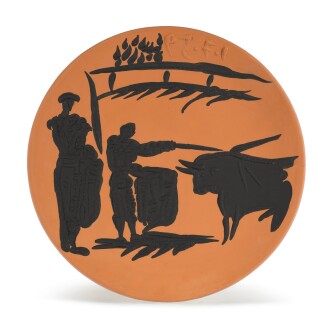I mportant Picasso Ceramics: Including works from the Nina Miller Collection features some of Picasso’s most masterful, inventive, and playful creations in clay. Made in collaboration with the esteemed Madoura Pottery in Vallauris, each of the works on offer will shed light on Picasso’s years in Southern France and honour their storied partnership. From functional plates to fanciful vases, this sale will feature a curated array of sculptural ceramics that are sure to appeal to both the first-time buyer and the established collector. Highlights of the sale include Picasso’s monumental Gros oiseau visage noir (A. R. 118) (Lot 15) the playful Taureau (A. R. 255) (Lot 44) and the majestic Canard pique-fleurs (A. R. 117) (Lot 14)
Featured Highlights
Picasso and the Corrida
Picasso was only a child when he saw his first corrida, which ignited a passion for the sport that repeatedly features in his work. He revelled in the illusionistic capacity of circular and oval ceramic formats, decorating plates and dishes with bullfighting scenes, letting the rims of the objects serve as arena stands. He also utilised the natural colouring of terracotta in works such as L’estocado (A. R. 430) (Lot 75) and Arrastro (A. R. 431) (Lot 76) to evoke the hot, red earth of the arena, which contrasts dramatically with the bulls and picadors delineated in black engobe decoration. Lastly he took advantage of the bulbous form of the pitcher to create his Taureau (A. R. 255) (Lot 44), a charging bull with a rotund and commanding stature.
“Picasso had several personal reasons to honour the bull: For its special significance in Spain, and thus a token if his own spanishness; for its virility; and for its tragic destiny in the bullfight”
Animal Influences
Picasso surrounded himself with animals – from dogs and cats, to birds, owls and even goats – living in seemingly symbiotic relationships with them that played an incredible fruitful role in much of his work. Many of the creatures represented in Picasso’s ceramics were of a deeply personal significance to the artist. Picasso’s father, himself an art teacher, specialised in painting doves and pigeons and it seems that his imagery had a profound impact on Picasso during his formative years. This is demonstrated by the fact that Picasso depicted birds more often than any other animal in his oeuvre. The presence of goats and owls in Picasso’s ceramics similarly reflects their personal meaning to the artist and the adoration he had for two of his pets Ubu, the owl, and Esmeralda, the goat. Paying homage to these animals, Picasso turned the most unexpected creatures into timeless icons. For example, vases take on the majestic and proud bodily features of his beloved Ubu in the Chouettes, a unique form invented by Picasso at the Madoura studio.
Ancient Forms
Picasso devoted much of his career to manipulating and distorting the classical canons of proportion, experimenting with ways to reimagine and redefine the visual representations of the ideal human body. Human forms and faces are a central motif throughout Picasso’s ceramics and the medium allowed him to explore diverse expressions and emotions in three dimensions. He aspired to creating forms that would serve a useful purpose in daily life while maintaining artistic merit; vessels that would straddle the line between functional and fashionable. By doing this he reinvented traditional forms, modernizing them with his anthropomorphic and zoomorphic designs. Visage is Picasso’s take on the ancient lekythos, while vessels such as the vibrant Visage aux yeux rieurs (A. R. 608) (Lot 115) a nd the majestic Vase deux anses hautes (A. R. 213) (Lot 40) mimic classical oenochoe and pelike. By applying his abstract anatomical patterns to early clay shapes, Picasso honoured and paid tribute to classical tradition while still defying academic expectations.


















